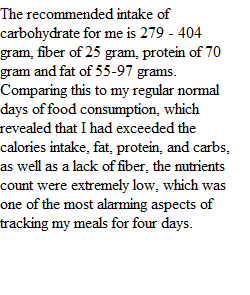


Q Be sure to include how your fats, protein, carbohydrates, sugar and sodium, and any other vitamin or mineral data you have compare to the Recommended Daily Allowances (RDAs) for your sex and age--see (Dietary Reference Intake calculator (Links to an external site.)). You will probably want to compare your "normal" to the RDAs, your "healthy" to the RDAs, then Describe problems and setbacks you had during your tracking days. Were these typical "normal" and "healthy" days, or did you have unusual circumstances? Did you have complete choice in your food options, or were there limitations? Identify ways you still need to improve your eating. What are some short-term and long-term changes you could make? What things would help you improve? Are there specific obstacles that you can strategize your way around? Lastly, at different points in our lives, we have different nutritional needs. You should be able to find good tools whether it's a year from now or 30. List three (3) website, books, or videos you could find to give you quality nutrition information. Cite the URLs or book title/author.
View Related Questions